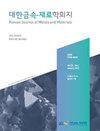Bytizite Cu3SbSe3:固态合成及热电性能
IF 1.4
4区 材料科学
Q4 MATERIALS SCIENCE, MULTIDISCIPLINARY
引用次数: 0
摘要
Bytizite (Cu3SbSe3)由于其超低的导热性而成为一种很有前途的热电材料。然而,实验研究很少。研究了机械合金化(MA)和热压(HP)合成Cu3SbSe3的最佳工艺条件。MA粉末表现为正交Cu3SbSe3相,即使HP后仍然存在。在x射线衍射图中还发现了透辉岩(Cu3SbSe4)和白闪石(Cu1.78Se)的次生相。热分析表明,MA粉末和HP压坯在727 K附近有一个较大的吸热峰,对应于Cu3SbSe3的熔点。在573 K以上的高温条件下,获得了相对密度大于99%的致密压坯。显微组织和元素分析证实了Cu3SbSe3基体中存在cu3sbse4次生相。而Cu1.78Se相未被观察到。所有样品的电导率为(0.66-1.06)× 103sm -1,塞贝克系数为324-376µVK-1, 623 K时的功率因数为0.09-0.11 mWm-1K-2。在测量温度范围内,热导率低于0.7 Wm-1K-1,这主要是由于Sb的孤对电子引起的声子散射。在423 K时,热导率下降,这可能是由bytizite的有序-无序转变引起的。ZT无因次值随温度升高而增大,在623 K时ZT最大值为0.16。本文章由计算机程序翻译,如有差异,请以英文原文为准。
Bytizite Cu3SbSe3: Solid-State Synthesis and Thermoelectric Performance
Bytizite (Cu3SbSe3 ) has attracted interest as a promising thermoelectric material because of its ultralow thermal conductivity; however, there are few experimental studies. This study investigated the optimal processing conditions for the synthesis of Cu3SbSe3 using mechanical alloying (MA) and hot pressing (HP). The MA powder exhibited an orthorhombic Cu3SbSe3 phase, which remained even after HP. However, secondary phases of permingeatite (Cu3SbSe4) and berzelianite (Cu1.78Se) were also identified in the X-ray diffraction patterns. Thermal analysis revealed that the MA powder and HP compacts exhibited a large endothermic peak near 727 K, which corresponds to the melting point of Cu3SbSe3 . Dense compacts with a relative density higher than 99% were obtained at HP temperatures above 573 K. Microstructural and elemental analyses confirmed the presence of the secondary phase Cu3 SbSe4 in the matrix of Cu3SbSe3 . However, the Cu1.78Se phase could not be observed. All specimens exhibited an electrical conductivity of (0.66–1.06) × 10 3 Sm-1, a Seebeck coefficient of 324–376 µVK-1, and a power factor of 0.09–0.11 mWm-1K-2 at 623 K. The thermal conductivity was lower than 0.7 Wm-1K-1 in the measured temperature range, mainly due to the phonon scattering caused by the lone-pair electrons of Sb. A dip in thermal conductivity was observed at 423 K, which was possibly caused by the order-disorder transition of bytizite. The dimensionless figure of merit ZT increased with increasing temperature, and the maximum ZT was 0.16 at 623 K.
求助全文
通过发布文献求助,成功后即可免费获取论文全文。
去求助
来源期刊

Korean Journal of Metals and Materials
MATERIALS SCIENCE, MULTIDISCIPLINARY-METALLURGY & METALLURGICAL ENGINEERING
CiteScore
1.80
自引率
58.30%
发文量
100
审稿时长
4-8 weeks
期刊介绍:
The Korean Journal of Metals and Materials is a representative Korean-language journal of the Korean Institute of Metals and Materials (KIM); it publishes domestic and foreign academic papers related to metals and materials, in abroad range of fields from metals and materials to nano-materials, biomaterials, functional materials, energy materials, and new materials, and its official ISO designation is Korean J. Met. Mater.
 求助内容:
求助内容: 应助结果提醒方式:
应助结果提醒方式:


